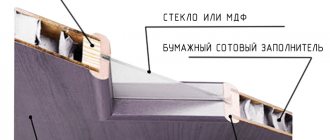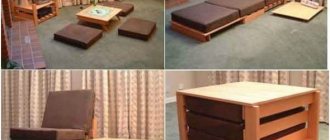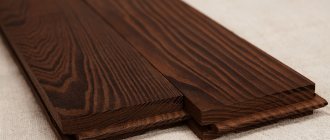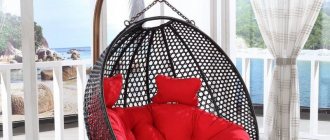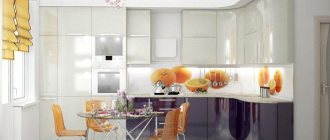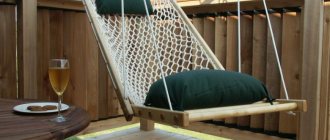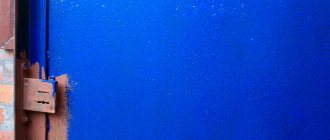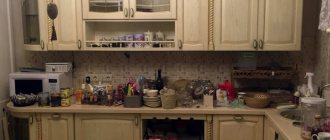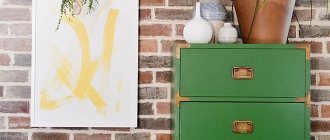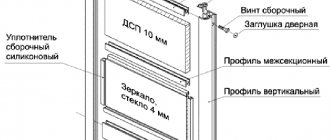Furniture requires protection from external factors. If we are talking about a kitchen set, then it is affected by changes in temperature and humidity. To create a protective barrier, you can apply coloring. Kitchen facades should be painted using suitable paints and varnishes. The process and intricacies of the work will be discussed in detail below.
How to Use Chalk Paint
When people ask me how to use chalk paint correctly, I always have a hard time answering.
I realize I'm expected to give detailed instructions, but painting with chalk paint is so easy that the only instructions are to open the can, dip a clean brush into it, and start painting! It doesn’t matter what kind of furniture you need to repaint - MDF, chipboard, laminated chipboard or a Soviet glossy polished cabinet. The instructions remain the same - just open the can, dip the brush and start painting
However, in this article I have tried to collect the most common questions I receive about how to repaint furniture with chalk paint.
Do I need to remove the clearcoat or previous paint before repainting? No no need. Chalk paint is suitable for repainting most surfaces without prior preparation - sanding or priming. Why do I say “for the majority”? Because sometimes it happens that for better quality repainting you need to use, for example, a primer. Those. You can repaint it this way (the paint will fall off), but if the surface is very old or was covered with drying oil, oil compounds, or it is not clear what it was coated with, then stains may appear through the paint. This often happens when repainting kitchens, for example. In cases like this, I recommend using a stain-blocking primer. This will save you from unnecessary work later.
Should furniture be sanded before repainting? No no need. Chalk paint has increased adhesion to the surface. It is applied with a roller, brush, sponge and even fingers directly to the surface. In exceptional cases - for example, the furniture has recently been coated with a fresh coat of wax - you can lightly go over it in a circular motion with a sanding block. But there is no need to peel off the top layer, just lightly “dust” the surface.
How to prepare furniture for repainting with chalk paints? The only thing that really needs to be done is to clean the furniture properly. If you are working with old furniture (especially if you bought it and don’t know where and how it was kept), then use a solution of soda and water to clean it. If the furniture has an unpleasant odor, sprinkle baking soda in corners and surfaces and leave it for a day; it absorbs odors perfectly. If the furniture is not too old, it is enough to wash it with water and let the surfaces dry naturally. Before repainting furniture, I always recommend degreasing the surface. This can be done with a simple degreaser, which is sold in construction and hardware stores.
What brushes should I use for chalk paint? When using chalk paint, choose any brushes and rollers that are suitable for water-based paints. Soft synthetic, natural bristles are always a great choice. In the case of rollers, simple rollers with natural fur (short pile) or flock rollers are suitable.
Do I need to thin chalk paint with water? No, the brush does not need to be wetted with water, and the paint does not need to be diluted with water, as we are used to doing when painting with watercolors or gouache. The work begins with a dry brush, which you simply need to dip into the jar. However, to create special decorative effects (glaze, for example), you can use water. It is not prohibited. Our paint is quite thick, which is necessary for a number of artistic techniques. If you need a more fluid paint, you can dilute the paint slightly by adding water to the jar itself (a teaspoon at a time) and stir the paint.
Is it possible to mix chalk paints with each other? Of course you can. You can create new colors by mixing paints with each other. You can mix paints directly on furniture to create special decorative effects.
How to protect repainted furniture? Depending on how the furniture is intended to be used, wax or varnish can be used as a finishing coat. Wax highlights the matte velvet finish of chalk paint, while varnish provides greater protection. For wet rooms and kitchens, I recommend using varnish. For furniture in rooms, I prefer to use wax.
How to use chalk paints? To summarize, the instructions are as simple as possible:
- Clean the surface: wash, degrease
- Open a can of paint
- Dip the brush/roll the paint into the tray (if painting with a roller) and start painting.
If you have any questions about how to properly use chalk paint, write to us and we will answer!
How to remove old paintwork
To make it easier to remove the previous layer, you can heat it with a hair dryer, then the adhesion decreases and the layer itself comes off a little. There are also special washes on sale, but you need to remember that they have a strong smell, and you need to wear a respirator and create effective ventilation when working inside a building.
Or you can use sandpaper; you can use it to remove the layer, but the process will not be quick. A lot of dust is also generated to make the process easier; it is vacuumed regularly. Make sure not to touch the façade material itself and not lose the desired evenness. This method is used if other options are not available.
Not in all cases it is necessary to remove the entire layer; sometimes it is enough to ensure roughness to obtain optimal adhesion. But only if the paint holds well.
To make it easier to remove the previous layer, you can heat it with a hair dryer, then the adhesion decreases and the layer itself comes off a little.
Repainting the kitchen facade will help to update the interior of the room on a budget, because the kitchen set is one of the important elements in this area. You need to choose high-quality paint so as not to spoil the furniture and get a beautiful design. You can carry out the work yourself, the main thing is to follow the painting technology. Do not neglect the preparatory part so that the paint lays evenly and no flaws remain.
Why is this necessary?
Painting and repainting furniture is an interesting and inspiring procedure. It’s no wonder that social media accounts dedicated to restoration work attract thousands of followers. People are interested in watching how craftsmen use their own hands to make modern Scandi-style furniture from grandma’s old cupboard. Or how an unpretentious chipboard coffee table can be turned into a fashionable interior accent.
Restoring old furniture is both saving money and a great way to extend the life of a not very fashionable, but strong and reliable design, and a great opportunity to turn something outdated into something current. And if professional restorers have a lot of tools, methods, technologies, home craftsmen can limit themselves to the most accessible ones. Repainting furniture is the main one.
Here are 5 reasons to repaint chipboard furniture.
- It will merge with the overall ensemble of the interior.
- It will look modern.
- The situation will change, and so will the mood of the household.
- Minor flaws and deformations created by time will be hidden under a layer of paint.
- This is a great DIY renovation experience that won't hurt anyone. And if in the future you want to save on the services of masters, you can start learning right now. And repainting is an ideal activity for beginners.
Should I choose gloss?
Today, there are a large number of options for decorating kitchens - it can be imitation of natural wood or stone, brass, patina, antique painting, various patterns.
When deciding between a matte and glossy finish, some people have doubts, because gloss is very easily soiled. They say that all the prints and stains are visible on it. In addition, the gloss of a bright shade may look “tacky”. Let's not lie - there is some truth in these statements. However, this is not a reason to give up gloss!
Of course, if you have a large family with small children, then painting MDF gloss monochrome black is not the best choice. Dark gloss is suitable for kitchens where cooking is not done very often.
Gloss in light shades is a good choice for any small kitchen, as such coatings visually expand the space. However, we would still recommend avoiding glossy countertops for reasons of practicality.
As for the “tackiness” of bright shades, you must agree that if you want something juicy, you don’t have to paint the entire kitchen in the “uncontrollable tomato” shade. You can choose a calmer burgundy or, for example, make the facades matte and restrained in color, and highlight the corners and transitions with a bright and rich gloss. By combining different textures you can achieve a very beautiful and unique effect.
Can we get to work?
We've sorted out the choice of materials, now let's move on to changing the old furniture. For clarity, we chose two different surfaces: a laminated chipboard cabinet and an MFD shelf.
We will share the easiest and fastest way to color them. Even a beginner can handle this.
First, let's take the necessary tools, namely:
- Several brushes (It is better to buy not the cheapest ones, since there are times when they fall off. This will not have the best effect on the coloring composition)
- Roller
- Masking tape
- Priming
- Sanding cloths
We also took:
- Gray acrylic paint (The most common option, so we’ll focus on it)
- White acrylic
Remember! The lighter the surface, the more difficult it is to paint. This is a painstaking and complex process that requires the application of many layers. If light paint is not necessary for the interior, then it is better to take a different color. This will make it easier for you
task.
- Oil paint for wood
- Varnish
The entire handmade transformation process is divided into two stages:
Grinding
When the putty solution dries well, the base is brought to perfection. Use coarse sandpaper and sand the surface until it is smooth. Then replace the sandpaper with a smaller version so that the smoothness becomes better.
It is optimal to choose the sandpaper grain numbers P400 or P600.
When the putty solution dries well, the base is brought to perfection.
Chalk paints - characteristics
There are many types of chalk paints on the market, they differ from each other mainly in additives. All products of this type consist of chalk and water (in varying proportions). In addition, they may include:
- resins of synthetic or vegetable origin;
- silicates;
- casein;
- linseed oil.
Depending on the additives, resin paints, mineral paints, milk paints, oil paints and the like are distinguished.
When considering these options, it is difficult to separate the best and worst quality because it all depends on whether they are used properly and in accordance with their intended purpose. For example, for furniture that hasn't been used much, medium quality paint works well. However, already in the kitchen and bathroom, the coating must be resistant to moisture and variable temperatures.
A completely different type of paint will also be needed to cover varnished or varnished hardwood surfaces.
Coatings for decorating fabrics and upholstery will require another type of chalk paint.
Common features of all chalk compositions:
- good adhesion;
- dullness;
- fast drying time;
- environmental friendliness;
- do not cause allergies;
- simple preparation of the substrate.
Polishing painted MDF facades
Before you start polishing, it is necessary to remove roughness and inclusions on the end and main surfaces of the parts.
The façade surface is wetted with water and sanded within a few minutes using an eccentric sander and 1500-grit sandpaper. Quality is controlled visually.
Subsequent polishing is carried out using a polishing machine and polishing wax (semi-liquid compositions of varying degrees of abrasiveness, intended for polishing with flexible end washers).
Initial polishing is done with a #14 hard polishing pad and Farecla G3 polishing wax. When polishing, follow the rule: apply liquid wax to the surface to be polished, and hard wax to the polishing tool, wetting the surface of the facade with water.
electronic lock for the front door of the apartment
| Rice. 16. Preparing the facade for polishing |
| Rice. 17. Polishing the facade |
Finish polishing is carried out with a soft polishing wheel and Farecla G10 polishing wax.
Gloss polishing or finishing polishing is done with a sheepskin wheel. Polished areas, dents and scratches are not allowed.
Varieties
When looking for paint for children's furniture, you should pay attention to the conditions of use, and not to personal preferences. The basic factor is the type of surface, since metal and wooden furniture have their own separate paints and varnishes
The most popular are acrylic paints, since their composition is environmentally neutral. This allows you to use the paint in any room. After the liquid evaporates, an elastic film forms on the treated surface. The paint contains a polymer that provides high-quality adhesion of the paint and the surface, as well as a fine polyacrylic dye.
Fillers are responsible for the level of gloss and dullness. Since wood requires protection, antibacterial fillers are also added to the paint. There are also additives that affect the thickness and drying time of the paint. The good thing about acrylic paint is that it can be removed before it has completely hardened. How to remove paint? It is best to use warm water and a sponge. Acrylic paints are almost the only material that allows moisture to evaporate, but does not allow it to pass through. It turns out that the surface of the furniture will breathe. It does not matter with what intensity the paint is used, since the color fixation lasts for decades. There is no need to think about how to remove the smell of paint, since acrylic paints practically do not have it. This means that the furniture can be placed in any room, even without ventilation. It is also worth mentioning such types of paint as:
- Gouache and watercolor - you can use them to paint furniture. They can be used exclusively as material for artistic coloring. For the main background, it is better to use other types of media. The properties of the material include dissolution in water and fading in the sun. Furniture with a printed pattern should be kept away from water sources and sunlight. Cleaning off the paint is quite easy. The advantage can be considered the relatively low price of the material, thanks to which you can often experiment;
- It is impossible not to mention paints and enamels based on organic solvents - they can be combined into one group. Oil paints are outdated because they do not last very long on the surface. The average period is approximately 3-5 years. But oil paints provide high-quality gloss;
- Automotive enamel (spray paint) may be suitable for furniture facades. It must be used if the facade is plastic or metal. It is not recommended to use automotive paint on wooden furniture;
- Paints can also include varnishes and impregnations, as they can change the appearance of an object. Impregnations and tinting additives are used already on the painted surface, when it needs to be given a special look. As for varnishes, they, like paints, can be oil, acrylic, or nitrocellulose. Both impregnations and varnishes can only be used if the furniture is wooden. They penetrate deep into the structure of the tree, protecting wood fibers from pests;
- Silicone-based water-based paints are odorless and can be used to seal cracks. The coating will last a long time, even if the furniture is placed in a room with a high level of humidity;
- As for latex-based water-based paint, its properties can be compared to oil paint. But at the same time, it does not have a pungent odor. This paint can only be used in warm rooms, since at low temperatures the coating may begin to crack;
- Alkyd paints do not react to humidity in any way, and they cost an order of magnitude lower than water-based materials. Such a coating will not have a long service life, since the film will have a thickness of no more than 0.1 mm.
If acrylic paint is not suitable, then you can choose chalk paints. The chalk paint recipe involves using an acrylic or latex mixture - this will act as a base. Plaster or grout for narrow joints can act as a fixative. Water is also added to the mixture. How to make chalk paint? Usually the proportions of water and fixing element are one to one, and paint is added at discretion.
The point of creating chalk paint is that the material is unique in its versatility - chalk paint applies to any surface with the same quality. It can be used for chipboard and any other surface. The paint can be used without prior surface preparation.
AcrylicGouache and acrylic
Oily
Enamel for cars Water-based
Latex
Alkyd
Application of primer
Application of primer FP 285 V (ICA)
| Rice. 4. Preparation of working soil solution |
| Rice. 5. Adding hardener |
During operation, it is necessary to maintain a constant viscosity for 20-25 seconds (Ford mug no. 4), adding solvent if necessary.
When applying two layers, the viscosity for the first layer of primer is 50 sec.f., the second 25-35 sec.f., the second layer of primer can be applied after 1-4 hours without waiting for it to dry completely.
The wall in a private house is damp
| Rice. 6. Blowing the facade before applying primer |
The survivability of the working solution with hardener is 4 hours. Apply the primer solution with a paint sprayer with a nozzle diameter of 1.8-2.0 mm and a pressure of 2.5-2.8 atm.
Soil consumption per layer is 150-200 g/sq.m. Dry from dust 15 minutes after applying primer, touchable after 30 minutes, sandable after at least 10 hours, completely dry 12 hours.
| Rice. 7. Application of primer |
| Rice. 8. Drying MDF facades with primer applied on a shelf |
Intermediate sanding is done with sandpaper no. 280 grit, the second layer of primer is sanded with sandpaper no. 320, careful blowing of the parts is necessary.
| Rice. 9. Sanding MDF primer |
Drying of the insulating soil is carried out under natural conditions at a temperature of 18-25 C for 4-16 hours.
Such a long time is due to the fact that the curing of polyurethane coatings is not only a physical process, but also a chemical process that occurs over a certain time, during which a chemical reaction of the polyol with isocyanate occurs, with the formation of cross-linking and the formation of a three-dimensional structure.
The excess presence of isocyanate in the soil binds OH groups from the moisture of the slab and contributes to the formation of a more branched polymer structure. The primed surface must be smooth, without missing layers of soil.
Drips, stains, stripes, bubbles, scratches, peeling of the primer, and mechanical damage are not allowed. When sanding, sanded or unsanded areas, dents, scratches and deep scratches from the skins are not allowed.
Repairing and painting kitchen furniture - step by step
Painting kitchen furniture is not a difficult task. However, before starting this activity, it is worth obtaining the relevant knowledge. Thanks to this, painting will definitely bring the desired effect.
Preparing for painting
Before starting any work, carefully inspect each cabinet.
Any deeper scratch should be filled with glue or wood compound. You can try smoothing out smaller scratches with sandpaper. Abrasion is always carried out along the fibers so as not to damage them. If the furniture is covered with film or plywood that is peeling, it should be torn off.
To make painting kitchen furniture more convenient, you should disassemble the facades and remove all the drawers. Cabinets should be thoroughly washed with water and detergent. It is also important to degrease the surface, for example, wipe with acetone or gasoline. All door handles must be removed
The last thing you need to do before painting your kitchen cabinets is to matte them. Cabinets should be sanded. This procedure will allow the paint to adhere better to the surface of the furniture. If the furniture has been varnished or painted, 240-grit sandpaper is sufficient. When making veneered or laminated cabinets, 400-grit paper should be used and the matting should be done very carefully.
Kitchen furniture repair - selection of tools
Before you begin the activity of painting kitchen cabinets, you should select the right tools. As a result, the resulting surface will be smooth and even.
A flat or round brush only works with chalk paints. With other types of kitchen paint, brushes can leave unsightly streaks. Therefore, when painting large surfaces, such as cabinet fronts, it is best to use wide rollers. Foam rollers are best, flock rollers will also work.
Painting the kitchen unit
After proper preparation, you can begin painting your kitchen furniture. Before applying paint, use a primer first. The primer used should be from the same manufacturer as the kitchen paint. Then you can be sure that the products will harmoniously combine with each other.
After the primer has dried, you can apply paint. It is most convenient to paint using the aforementioned wide roller. Small elements, nooks and crannies are easier to cover with a small brush. After the first layer has dried, apply the second. Drying time and number of layers depends on the manufacturer.
As a standard, you should apply at least two coats of paint. It is best to apply them in a cross pattern: the first from top to bottom, the second from left to right. If two coats are not enough, continue applying more until the paint completely covers the furniture.
Apply as thin layers as possible. Thanks to this, the resulting coating will be even and smooth. Please note that the paint takes about 20 days to acquire its properties. After this time, be careful not to damage the delicate coating. Use a soft cloth or sponge to clean
Repairing kitchen furniture does not have to be expensive. A simple solution - painting kitchen furniture - is a good idea for the metamorphosis of the kitchen. All you need is the right paint, a few basic tools, and good cabinet prep. This simple procedure will allow you to completely transform your interior at low financial cost.
Painting kitchen cabinets in a few steps:
◄ We disassemble all the cabinets. We separate the fronts of cabinets and drawers from the cabinets. We deprive the furniture of handles, hinges and possible fittings.
◄ We clean individual elements from dust and other contaminants.
◄ The surface of the furniture must be rough. In the case of wooden furniture, you can use a grinder; furniture made from veneered boards is cleaned manually with sandpaper.
◄ Before painting, thoroughly clean all elements - you can use gasoline for this.
◄ Apply the first coat of paint with a roller and wait until completely dry. When this happens, you can apply a second coat.
◄If you are painting with acrylic paint, it is worth covering the cabinets with a layer of clear varnish, which will protect the paint from abrasion and moisture.
◄ Done – the cabinets can be assembled and put into place!
Finishing and decorative processing
The process should be completed by polishing. Use sandpaper to remove defective parts, then use linen cloth impregnated with special products and polish the furniture. In order for the effect to be high-quality, the application is done quickly, and in three layers, each must dry for 12 hours.
Decoration is carried out on a dried coating, and finally the surface is treated with finishing compounds. There are the following options for decoration:
- Creating an aged coating. Patinated material is used, which is spread over the cabinet using a sponge or brush. Next, the surface is polished;
- Decoupage, the effect is obtained using the decoupage technique;
- You can draw a variety of patterns; for this you need stencils; there are ready-made templates for sale, or you can make them yourself;
- Chaotic irregularities and patterns can attract the eye. To create them, you can simply apply paint with a sponge, stamps, brushes, etc.;
- You can combine several colors, highlighting textured details, you can also paint the inside and outside in different tones, highlight the ends;
- Sometimes they resort to decorative details. Pebbles, rhinestones, etc. are glued on.
There are no restrictions in terms of decor, you shouldn’t overdo it, but you can show your imagination. And create an original design, not forgetting about the skillful implementation of the idea into the overall interior.
Patinated material is used, which is spread over the cabinet using a sponge or brush.
Kinds
The division into types is carried out due to the composition of the paint and the type of surface obtained as a result of applying the layer. Created by a British designer in 1990, chalk paint had an original composition and was sold under the Chalk Paint brand. The recipe for this composition has not yet been revealed, so there are many copies on the market made from a variety of components. All paints are water-based, and the additives present in them give the chalk compositions their corresponding names.
Resin paints contain resins of natural or synthetic origin. The mineral species contain silicates.
Milk paints have casein as an additional component, while oil paints contain linseed oil. Any of these paints can be used for artistic painting on glass, metal or wood, the main thing is to choose the appropriate option.
Ready-made chalk compositions are available in jars or cans. The most famous today is a Finnish manufacturer that produces a wide range of paint and varnish products, including slate paint. The coating formed by chalk paint can have a surface of different textures: smooth, suitable for drawing, and lumpy, with a relief.
Swedish or Finnish paints, which form a smooth or structured surface, belong to different types, and differ in some components that impart certain properties to the applied layer. The basis of textured or slate paint is acrylic, silicone or latex (rubber) emulsion.
To impart magnetic properties to the slate surface, small metal particles are added to the latex emulsion. They are what give the paint its magnetic properties. Magnetic paint adheres well to any materials, and the resulting surface is a good help in educational activities for children.
Emulsions that create a slate effect on the surface are usually dark colors: black, gray, metallic, dark green, burgundy and brown. This is necessary so that the chalk pattern is visible on the surface. A colorless base is also available, which can be given any shade by adding color to the container or painting a colored surface.
To decorate individual objects and paint walls, pearlescent paint is often used. White color is most often used to finish the ceiling surface. Whitewashing the ceiling can be done either with ready-made compounds or prepared at home. For materials exposed to heat, special heat-resistant or fire-resistant compounds are used.
In order for the applied design to stay on the surface for as long as possible, the decorated object is sent to the oven for firing. The possibility of prolonged temperature exposure is possible due to the high heat resistance of chalk compositions. These include stained glass paints used for painting on glass or ceramics.
Is it possible to repaint the façade?
It is possible to repaint the facade, but it is important to thoroughly clean it of the old finish. So that poorly adhering paint does not create defects that will be very noticeable on the new layer. Also, an old smooth coating will make it difficult for the elements to adhere; you need to get a rough base, then the quality of the paint will be high.
It is possible to repaint the facade, but it is important to thoroughly clean it of the old finish.
Surface decoration
Sometimes you also have to decorate furniture made of chipboard. For example, hand-painted furniture is transformed. Let those who think that he has had enough of painting and is not an artist at all should not rush to be indignant. Today, fortunately, stencils are actively used, which make furniture unique, special, atypical.
Applications and prints on furniture are an interesting solution. You can use the same stencil to make some kind of inscription that is important for the owner or household members.
Interesting idea! If repainting involves a child's desk, there is always the problem of quickly deteriorating the updated look of the furniture. Traces of plasticine, paint, etc. will soon appear on the countertop. You can use a clever decorative technique - make the tabletop in the shape of an artist’s palette. That is, create these paint stains, fingerprints, splashes on purpose. Involve children in this process - they will only be happy. And then paint the top with one layer of white paint so that the table in the form of a palette is not very bright. And finally - protective varnish.
If we are talking about the same desk or, for example, a chest of drawers, you can “get confused” about the interior decor. For example, upholster the inside of the drawers with fabric. The work is painstaking, but the result is delightful. The fabric is chosen at the discretion of the master - it is convenient to work with colorful natural fabrics. Then the table becomes not just retro furniture, but a luxurious antique.
Requirements for the surface to be finished
The recommended profile milling depth is no more than half its width. It is necessary to avoid straight and sharp corners in the profile to ensure its coverage with paint and varnish material.
The milled edge must have rounded edges (rounding radius of at least 2 mm), since it is the sharp outer corners that are poorly coated with paintwork and during subsequent sanding, a thin layer of coating is removed from them. It is these areas that become the source of internal stresses and the subsequent formation of defects in the form of cracks.
Internal sharp corners serve as a source of excessive flow of paintwork into them, which is poorly dried; the solvent that does not come out of them can lift subsequent layers of paintwork, and this can lead to swelling of the paint layers and its peeling off from the surface of the slab.
The MDF board is tested for density, surface roughness and moisture content. The humidity of the parts should be within 8+2%, the temperature on the surface of the parts should be 18 C.
The roughness for finishing should not exceed 16 microns according to GOST 7016. Sanded parts should not lie in a workshop or warehouse for a long time, since under the influence of changes in temperature and humidity in the room, after 3-4 days in damp weather they become rough. Finishing should be done immediately after sanding.
The surface of parts made from MDF boards should be free of protrusions, dents, scratches, stains from oil, paraffin, glue, foreign inclusions in the form of bark, chipped edges and corners.
If the slab is milled, then it is necessary to check for the absence of traces of cutter runout, depressions, protrusions, edge chips and corner chipping, fringes, oil stains, and slab delaminations. The surface must be thoroughly cleaned of dust.
What is MDF
First, it’s worth understanding what MDF is. Translated from English, the abbreviation “MDF” translates as “medium density fiberboard.” This material is made from wood fibers.
MDF production includes the following stages:
- Sawdust is crushed to a powder state. To do this, the raw materials are brought to 100 degrees temperature and 80 percent humidity. And then it is ground in a defibrator.
- Then urea-formaldehyde resins and paraffin are added to the powder. The mass is thoroughly mixed and dried at a temperature of 200 degrees. By the way, the mixture dries within a few seconds.
- The resulting mass is transferred to a hopper and compacted, and then rolled out with a roller along a conveyor. This creates a slab.
- It is fed to the press, and under a pressure of 350 MPa and when heated to 230 degrees, the pressing stage goes through. After this, the pressure decreases three times and the process of adjusting the thickness of the plate takes place without high temperatures.
- The cooled slab is sanded and cut into pieces of the required size.
If you cannot find special paint for MDF, you can use painting compounds for windows and doors, or for wood.
Fiberboard is one of the most commonly used materials in the furniture industry. And this is no coincidence. MDF has enough advantages:
- Moisture resistance;
- Strength;
- Availability;
- Long service life;
- Possibility of creating various reliefs and decor;
- Resistance to temperature changes;
- Wide range of applications.
You can paint the furniture yourself.
Often, happy owners of MDF furniture believe that it is impossible to repaint such interior items with their own hands. But in vain. Everything is much simpler than it might seem at first glance. The main thing is to choose the right paints, namely:
- Primer compositions;
- Paints with high hiding power and wear resistance;
- Varnishes or polishing kits.
With a wide range of colors to choose from, you are sure to find something that suits you.
By painting MDF surfaces, you will refresh the interior, extend the service life of products and significantly improve performance. The latter is especially true if you decide to update the furniture in the bathroom or kitchen.
Choose quality paint manufacturers.
However, there are also disadvantages to coloring. Firstly, it will cost you much more than covering the facades with decorative film. And, secondly, painted surfaces fade over time.
Purpose of describing the technological process of painting MDF facades
This description of the technological process is intended for obtaining opaque matte and glossy coatings. It is used for finishing relief facades and profile elements made of medium-density MDF boards. MDF board is confirmed by ISO 9001 certificate and meets the requirements of GOST 10632-89.
This technical description provides for the use of polyurethane paint OP 400 gloss and semi-matte produced by ICA (Italy), applied by pneumatic spraying with the obligatory use of polyurethane primer FP 285V from ICA (Italy).
Kinds
The main criterion that determines the characteristics of paintwork materials is the composition, namely: the type of filler and base. Conventionally, all paints for furniture are divided into water-soluble and insoluble. When working with the former, there is no question of what to use to wipe off the substance at the application stage - such compositions can be easily diluted with water and dry quickly without releasing toxins. This group also includes modern highly adhesive brands with a binder based on polymer resins, which after drying form a thin, vapor-permeable, but water-resistant film. Transparent paints include stain, wax, and various impregnations.
Compositions based on organic solvents are represented by oil, polyurethane and alkyd enamels. Their characteristics are far from ideal (the paint dries slowly, smells unpleasant and is most often flammable), but in terms of cheapness and water resistance they win. In particular, this type of paint is recommended to be chosen when using furniture in conditions of high humidity or outdoors.
Depending on the composition of the filler and purpose, the following are distinguished:
Acrylic paints. They are recognized as the safest and most accessible, and are actively used in children's institutions. The scope of their application is limited only by washability - painted coatings need frequent updating. Innovative highly adhesive chalk paints and their analogues with the addition of casein, linseed oil, resins, silicates. After drying they form a beautiful matte finish. Such brands allow high-quality painting of furniture made of chipboard, laminated boards or plastic; their only disadvantage is their high cost. Traditional oil paints. Apply outdoors or in a well-ventilated area and dry for at least 3-4 days. Alkyd-urethane enamels. Forms shiny coatings that are resistant to most external influences
Requires careful handling due to the release of toxins during drying. More often used in production than in everyday life. Expensive latex and silicone water-based compositions
Ideal for furniture that is frequently exposed to moisture. Paints based on polyurethane resins. Used for painting washable furniture surfaces.
Purpose of furniture wax, advice on the correct use of the composition A separate group is represented by specialized products: compositions for restoring leather based on natural waxes, leather paints with the addition of synthetic resins, powder mixtures based on polyesters, epoxy-polyester mixtures. Such brands have a narrow scope of application and are more often used when serious repairs are necessary. The method of their application and compatibility with other coatings are specified in advance.
Acrylic
Cretaceous
Oily
Alkyd-urethane
Latex
Based on polyurethane resins
Necessary materials
Materials and tools for painting MDF furniture
In order to paint MDF furniture at home, you will need:
- dye;
- primer;
- putty;
- solvent corresponding to the selected paint;
- masking tape;
- covering film.
Depending on the chosen painting method, you will need the following tools:
- sandpaper, mesh and sponge with different grain sizes;
- brushes, rollers, spray gun;
- narrow and wide spatula;
- stationery or construction knife;
- Screwdriver Set;
- protective gloves, glasses, respirator;
- clean rags.
You will also need patience and a firm intention to create a miracle.
Tools for painting furniture
Types of paints
The finish for repainting furniture should be safe, practical and beautiful. The material can completely transform facades or add new notes to the existing design. There are 6 types that are used for interior items.
Silicone water emulsion
Paint is made from a color mixture based on water, polymers and dyes. Emulsion particles are dissolved in liquid. After application to the surface, the moisture evaporates, but the pigments with the fixer remain. Finishes containing silicone penetrate well into the upper layers of wood.
Long-lasting paint does not crack or peel, and the color does not fade. The material perfectly allows oxygen to pass through, so painted facades do not swell (do not “bubble”). The resin-based pigment “breathes” but does not absorb moisture. After application, the components dry quickly. Antibacterial additives are often added to the composition to protect the wood from rot and mold.
Silicone paintSource berkem.ru
Silicone water-based emulsion masks minor mechanical damage (up to 2 mm), so the finish is used without sanding or putty. Due to the antistatic properties of the material, dust does not accumulate on painted facades. The raw materials do not have a sharp, chemical smell, which allows them to be used in children's rooms. The only disadvantage of enamel is the high price.
Acrylic
Furniture paint combines the best properties of water-soluble and oil-based types. There are no toxic components in the composition, so the material does not stink and is safe for use indoors. Due to the high level of adhesion to the surface, it fits perfectly. To obtain uniform coloring, 2 layers are sufficient. Drying period – 2-3 hours.
Material option for furnitureSource vmirekraski.ru
After the paint has hardened, a thin protective coating appears on the furniture, resistant to mechanical damage and aggressive environmental influences. Due to the absence of flammable components in the composition, the raw material is highly fire resistant. To obtain a uniform layer, the facades are primed before application and cracks are puttied.
Acrylic paintSource kraskidlyamebeli.ru
The elasticity of acrylic protects the surface from cracking and preserves the original appearance of the furniture. The paint is tinted, giving the material the desired color. The compositions are matte and glossy. The facades are easy to care for and can be sanded and repainted. To reduce the thickness of the enamel, use water rather than chemical solvents.
Latex
Practical and easy to use, furniture paint is a water-soluble type. The liquid makes the composition viscous, which makes it easier to apply to the surface. Latex penetrates the upper layers of wood, creating a protective film that protects against moisture. High air permeability will preserve the structure of the facades in their original form. The material is afraid of the cold, so interior items are placed only indoors.
Waterproof coating Source berkem.ru
Cretaceous
Professional compositions allow you to work with surfaces of any neglect. With the help of chalk paints for furniture, it is possible to create a perfectly even matte layer on the facades. To obtain a glossy shine, a finishing (wax) coating is applied on top. The material dries quickly and is suitable for wood, metal and plastic. The only negative is the high price.
Option for old furnitureSource livemaster.ru
Transparent
Paints are used to emphasize the beauty of natural wood patterns. Lacquered facades look more expensive and luxurious than matte ones. The glossy finish will make the design bright and clear. Impregnations can change the natural color by 1-2 tones.
Furniture varnishSource kraskidlyamebeli.ru
Varnishes, waxes and stains protect wood from drying out and fading in the sun. Transparent paints will protect furniture from mechanical damage. If the facades have lost their shine, the gloss can be easily restored by re-coating.
Organic
Enamels based on oil solvents have a recognizable heavy odor that does not disappear for a long time. Organic species emit toxic fumes that are hazardous to residential areas. The finish takes a long time to dry, burns and within 3 years loses its original qualities. Paints are used on a limited budget and for furniture exposed to humidity.
Organic look for furnitureSource berkem.ru
Facade painting
How the paint and varnish material will be applied is decided based on the task at hand and the color of the composition. But first of all, in any case, the ends of the parts are painted.
If you choose a spray gun as a tool and have no experience working with it, then it is advisable to try painting on an unnecessary object. It's also useful to do this after setting up the tool to make sure the settings are correct.
The coating is usually done in multi-layers, three are usually enough, but sometimes they decide to do more to get a rich layer. Each new layer is applied after 10-15 minutes for setting to occur. If they paint dark wood in a light tone, its texture will be completely obscured and the design will not be preserved.
The coating is usually done in multi-layers, three are usually enough, but sometimes they decide to do more to get a rich layer.
At-home coloring algorithm
Before starting repainting work, it is necessary to prepare tools and materials so that there are no delays during the repair, and to clearly understand the sequence of actions.
Preparing the workplace and product
The first stage of work is the dismantling of facade parts. They are carefully removed using screwdrivers, taking care not to damage the fasteners and facades. The removed elements are marked to facilitate further assembly of the headset. If the sidewalls and cornices need painting, they are also dismantled.
Prepare the workplace, taking into account the following points:
- free up space in the room to place all the parts to be painted;
- prepare tables, stools, boxes on which parts will be laid horizontally for drying;
- the room must have good ventilation, since solvents, primers, and paint have an odor;
- the floor and work table are covered with a protective film to protect from paint;
- the windows in the room are covered with insect nets (in summer), but open for ventilation;
- provide temperature conditions recommended for working with dye.
Decorating parts, locks, and glass are removed from the facades or carefully sealed with masking tape.
Grinding
Removing the old coating is the most labor-intensive process before painting the facades. For work use:
- a construction hair dryer for removing the protective film from chipboard or MDF boards - heat the surface and carefully peel off the film;
- the paint is removed with sandpaper or a grinding machine - the first stage is using coarse grains, then they move on to fine-grained materials;
- You can use special liquids to remove varnish and paint;
- the final stage is the removal of dust and crumbs (use dry brushes with hard bristles and a blow-out vacuum cleaner).
The dust is cleaned dry, then the parts are wiped with a damp cloth. Finally, the wooden parts are treated with a solvent to remove grease stains.
Primer
After removing the old coating, the facades are inspected and checked for chips and cracks. If necessary, all defects are eliminated with putty, since after painting even minor irregularities will become noticeable.
For the second time, use a white polyurethane primer. After drying, the parts are sanded again. The chipboard surface is leveled and primed.
Coloring
The paint is applied in 2-3 layers, placing the parts on horizontal surfaces to avoid smudges. Basic Rules:
- a thin layer of paint; before applying a second one, wait until the first one is completely dry;
- when using a brush or roller, they work only in one direction;
- When using a spray can, carefully cover all areas that do not require painting with film.
Readiness to apply the next layer is checked not with your hands, but according to the instructions for the paint (drying time is indicated there).
Finish
The final varnish coating is applied to increase the resistance of facades to mechanical stress and to protect the paint from chips and scratches. The varnish creates a thin film and additionally levels the surface. It is applied when the dye has hardened. Choose a varnish that matches the base paint.
When applying varnish, extreme care is taken so that dust particles do not spoil the coating (they are immediately carefully removed with a needle or tweezers)
Decorative processing
The decor will give the kitchen set uniqueness and individuality. It is applied after painting, before finishing the surface. Decor options:
- the use of contrasting colors or different shades of the same tone at the top and bottom of the set or in a thoughtful order;
- giving the paint layer a special texture - using a brush, brush, sponge, signet;
- glaze – the use of glaze to create a complex color scheme;
- creating patterns using stencils - ready-made or homemade;
- decoupage, patination;
- decorating elements - rhinestones, chains, carved handles that complement the fittings.
The decor of the kitchen set is carried out in accordance with the overall design of the room, taking into account the style decision.
Color palette
The variety of colors is impressive, you can easily choose the desired shade. There are ready-made shades that can be mixed if necessary to obtain the desired shade. Pigments can be added to the white base color to achieve the tone you like. There are also additives that provide the following effects:
- Matte, this option is usually chosen for furniture;
- Chameleon You can paint all the cabinets in the set, but stick to one tone so as not to overload with color, because the effect is complex. It is advisable that the shade be still somewhere in the interior;
- Gloss is also popular;
- Mother of pearl, experts recommend using it as an accent solution;
- Glow, looks stylish;
- Shimmering.
In order for the shade to turn out well, it is important to monitor the density of the layer and also dry it under natural conditions. Then the paint will adhere securely.
Be sure to read the instructions from the manufacturer, where the nuances of application may be prescribed.
The variety of colors is impressive, you can easily choose the desired shade.
How to choose the right one
There is no universal enamel that suits all interior items. When choosing, pay attention to the degree of neglect and operating conditions. To find paint for furniture, you need to use the rules.
Types of materials
Interior items made of wood absorb enamel more than plastic or metal facades. For coniferous wood, 2-3 layers of finishing are used; for maple, beech and birch, one is enough. Composite particle boards cannot be painted with solvent-based compounds.
Options for furniture Source kraskidlyamebeli.ru
If you need to revive the design of vintage interior items, it is recommended to use varnish. Glazed transparent material will make facades bright, add luxury and gloss. The coating will perfectly hide small cracks and small crevices and emphasize the volume of the carving.
Beautiful glossy facade Source nn.ru
Silicone paint can help change leather or leatherette upholstery. Wicker furniture is painted with acrylic. The original natural gloss of rattan interior items will be returned:
- wax;
- tinting impregnation;
- varnish
Second life of the closet Source yandex.ua
Features of caring for film facades
Caring for film facades is really easy. They should be wiped regularly with a damp soft cloth and any non-aggressive liquid detergent.
In order for furniture facades with PVC film to serve for a long time without losing their performance properties, it is recommended to follow a few simple rules:
- do not expose furniture to heat above 70°, do not place it near an electric stove, heaters,
- lighting fixtures, etc., to avoid film peeling;
- do not expose film facades to cooling below -15°, prolonged exposure to moisture or strong mechanical stress;
- Do not use abrasive, aggressive agents, solvents or liquids containing chlorine to clean facades.
If you treat furniture with film fronts with care, it will delight its owners for a long time with its bright colors and smooth surface.
Author: Alla Dobrokhotova
What to combine with a glossy set?
Whatever you say, a glossy set, regardless of color, will stand out and attract attention.
Glossy MDF painting is undoubtedly an accent in the interior. It is better to surround it with discreet matte surfaces. This applies to the tabletop - it will also be more convenient, but it is especially important for the ceiling and floors.
A glossy set in combination with a glossy ceiling will not look as impressive as gloss on a matte background. The combined facades look interesting - the top is glossy and the bottom is matte. Or, for example, all horizontal surfaces are dark matte, and vertical surfaces are bright gloss.
The combination of a glossy finish with natural materials or their imitation looks interesting. Wooden details or a stone countertop will contrast very favorably with the brightness of the gloss.
Gloss MDF painting is a suitable choice for any modern design. It doesn’t matter whether it’s high-tech, loft, modern or fusion. By choosing the right color you can easily fit such furniture into the interior.
How much does it cost to change kitchen facades?
Price for replacing kitchen facades
| № | Facade type | Price |
| 1 | MDF enamel facades | 4500 rub. |
| 2 | MDF plastic facades | 3200 rub. |
| 3 | Egger chipboard facades | 2100 rub. |
| 4 | MDF facades profile | 2800 rub. |
Interesting materials:
What is a correction factor? What is a social studies consumer basket? What is Trinity Day? What is pre-retirement age in Russia? What are the rectangular coordinates of a point? What is a launcher app? What are accepted and non-accepted expenses? What is Print Screen on a keyboard? What is grafting and for what purpose is it used in gardening? What is a space in text?
Painting stages
Preparatory stage
At the preparatory stage, you need to pay great attention to the processing of the slab. To treat the surface to a glossy finish, you need to avoid raising the pile and eliminating embossing that occurred during the production process
The MDF facade should be milled at maximum speed, which will avoid raising the pile. Since the paint layer here is very thin, it is advisable not to leave sharp corners that can be easily knocked off. For cutting corners, it is best to use an edge cutter with a radius of about 3 mm.
To properly sand the MDF facade, it is necessary to remove the surface protective wax layer from the entire surface. An eccentric type grinder is best suited for this work. To process complex curves, it is advisable to use sandpaper. If you plan to paint MDF wall surfaces that include several component elements, then it is better to properly fill the joint gaps with a primer to fill the pores.
Surface priming
At the first stage, the most problematic relief areas are primed. After this, the edges of the panel are primed. At the final stage, the entire facade is treated with soil. Using a primer gun, apply the solution first longitudinally and then transversely. In this case, each subsequent layer is overlapped with the previous one by 50%. This is how not only the primer is carried out, but also the painting itself.
The most effective primer application technology involves two stages. The first step is to use a spray gun to apply a layer of insulating primer. It should prevent the pile from rising and absorbing subsequent layers of paint. After this, you need to let the primer dry and sand the surface with P320-400 sandpaper.
The second step of priming is to apply polyurethane primer and let it dry for at least 10 hours. Next, the surface is ground, and Scotch-brite abrasive is used in places where milling bends are made.
Painting stage
To paint an MDF facade with high quality, you need to use a spray gun with paint consumption parameters of 60-200 g/sq. m. All other parameters of the device are set depending on the type of paint coating used. In this regard, before you paint the facade glossy, you need to thoroughly understand the instructions for using the paint.
Wet painting technology
After the priming stage, drying is carried out at a temperature not exceeding 35 degrees. The drying period is on average five hours. The wet painting method is carried out by applying a mixture with a thickness of 120 to 140 microns. It is advisable to use polyurethane paints and varnishes.
The paint is applied using a spray gun with a certain pressure. Application in two layers is also possible, but the surface should be sanded before applying the second layer. At the same time, the thickness of each layer should not be more than 120 microns. At the next stage, several layers of polyester or polyurethane primer are applied to the MDF board, simultaneously with intermediate sanding. The final layer of glossy enamel must be polished.
When applying complex compositions of paints and varnishes with different special effects, they must be mixed well. This is necessary so that the decoration parts do not settle at the bottom of the jar.
When painting and varnishing MDF surfaces, care should be taken to ensure that dust, insects or other debris does not fall on it. To remove them from a painted surface, you need to have tweezers with you. If you find smudges of primer or paint, they should be removed using a utility knife and emery cloth.
Powder mixture for painting
The dry painting method involves applying a special paint called a powder mixture. The technique involves spraying dry microparticles onto the prepared surface. After this, the applied paint is heated until it begins to melt. The result is an almost ideal, flat surface.
Drying
The final stage of any painting is drying the panels. This procedure must be carried out under certain conditions. In particular, the air temperature should be no more than 50 degrees, and humidity less than 80%.
Drying time largely depends on environmental conditions. Typically, it will take 5 to 10 hours to dry completely. In general, the lower the humidity and temperature, the faster the MDF board dries.
Glisal treatment
To give painted facades originality, the painted surface is given a non-standard structure. For this purpose, glisal is used to change the structure of the facades. Let's take a closer look at the technique of applying glisal:
- Let the painted facades dry completely.
- We dilute glisal with water strictly according to the manufacturers' instructions.
- Using a clean brush, apply the solution to the painted surface.
Next, let's get creative. The surface of the glitz can be treated with a piece of foam rubber or multidirectional brush strokes. Using crumpled polyethylene you can get chaotic broken patterns.
If the result of the work does not meet the consumer's expectations, then this can be corrected. We apply a new thin layer of glaze and try again to diversify the structure of the facades.
Glizal is quite convenient to work with, as it takes longer to dry than paint or varnish. Therefore, there is no need to rush, but rather do the work carefully. The painted parts are dried for about a day.
Important! To extend the service life of painted facades, you can cover them with a protective layer of varnish.
So, as we see, a painted MDF facade can be transformed quite quickly, and without involving craftsmen. You just need to show persistence and diligence, and the new MDF kitchen design in the house will very soon please the residents.
